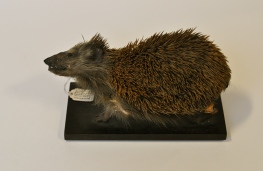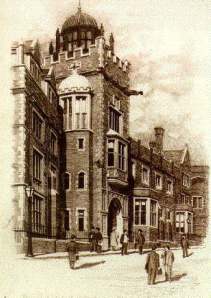One of the objects in our Hidden Histories exhibition is a model of a western European hedgehog, Erinaceus europaeus. This species is prevalent across the North and West regions of Europe and is found in wood and grasslands, although it has been known to venture into towns and cities due to their easy access to food sources. It is an omnivore, mainly consuming slugs, beetles and other insects, although it has been known to eat small rodents and young birds. The hedgehog has a strong phylogenic link with shrews and other small mammals, and models have been used extensively in the past as a demonstration tool for Biology Department lectures on anatomy and mammalian evolution.
Our taxidermy model hedgehog has been bisected on one side to display its skeleton and allow for a better understanding of its anatomical structure. The hedgehog has been taken from the larger zoology collection recently acquired by the Museum. This collection originally belonged to the Zoological Museum based in the Department of Biology. The Museum contained vertebrate, invertebrate, entomological (insect) and pathological collections, in addition to microscope and magic lantern slides. Parts of these collections date back to the beginning of the Yorkshire College of Science in 1874 and initially they were displayed in the corridors and around the sides of laboratories of the Biology Department, originally based in the second floor of Baines Wing. In 1908 the Zoological Museum was officially established and set up in the old botanical laboratory, where it remained until 1997 when the L. C. Miall building was opened. In addition to a new museum room, the Miall building contained store rooms, a preparation room, an insect collection room and a room for the department’s Herbarium.
The bisected taxidermy hedgehog displayed in Hidden Histories was bought by the Department of Biology from E. Gerrard and Sons, a London based taxidermy company, in August of 1934. The specimen cost £2-15-0, or £2 and 15 shillings. The hedgehog was not the only bisected taxidermy model bought in 1934; a rabbit and a bullfrog were also obtained for £4 and 10 shilling, and £1 and 15 shillings respectively. In addition to providing new specimens, the biology department relied heavily on E. Gerrard and Sons for cleaning, repairing and remounting services.
Whilst university natural history collections, such as those held by the Zoology Museum at Leeds, were used extensively in the early 1800s as a teaching resource, a rise in laboratory based work and cellular and molecular biology in the early- and mid-1900s saw the use of these collections reduced. However by the 1990s subjects such as biodiversity and wildlife conservation were becoming increasingly prominent and natural history collections became important again for both teaching and research. In spite of this, university collections remained at risk of being sold or given away due to financial problems. The Zoology Museum at Leeds seemed to avoid this financial pressure, and after the move to L. C. Miall and the better access the new rooms provided the collections became exceedingly popular amongst students. The collections were used to teach subjects such as vertebrate comparative anatomy and entomology, in addition to providing research material for final year students.
In recent years the collections have been used far less in teaching, although their involvement did not stop completely. In 2011, during my first year as an undergraduate in Biology and History and Philosophy of Science, we used skeletons within the Zoology Museum in a practical session for the Diversity of Life module. The practical involved measuring various bones of the hind legs from mammal skeletons within the collection to better understand how leg structure depends on the animal’s size and way of life.
Sadly the Zoology Museum closed in 2012. A large number of the skeletons and skulls have been retained and displayed around the foyer of the L. C. Miall building. Some of the collections, such as the Herbarium and majority of the insect collection, were given to the Discovery Centre of Leeds City Museum. The remainder of the Zoological Museum has been passed onto us within the Museum for the History of Science, Technology and Medicine, forming part of our biological science collection. Whilst we do not have the space at the moment to display the whole collection, which includes skeletons, skulls, coral, taxidermy and specimens preserved in spirits on a large scale, we are doing our best bring it to the attention of a wider audience . This includes representing it in the Hidden Histories display and a smaller display outside the Gillinson Room within the Philosophy department. In addition to this, we are trying to use the collection for its original purpose: teaching. Recently the Museum carried out a workshop with a local school using skull’s from the collection to highlight natural history and how an animal’s skull can help to reveal its life style, size and habitat. The workshop also focused on the importance of objects as a source of information in their own right. In addition to the natural history workshop, the school group attended a Victorian medicine workshop, and in the afternoon put together their own displays using various objects from our museum store. The day was very successful, and the students gave some wonderful feed back. Hopefully our natural history workshop will become as popular our Victorian medicine one.
For information on the history of the Zoology Museum and its collections, and also university natural history collections in general see:
Baker, R. A. ‘The University of Leeds Natural History Collections – Part 2’, The Biology Curator, 15 (1999), pp.2-4
Baker, R. A. & Edwards, J. M. “Louis Compton Miall (1842-1921) – the origins and development of Biology at the University of Leeds”, The Linnean, 14 (3) (1998), p.40-48








